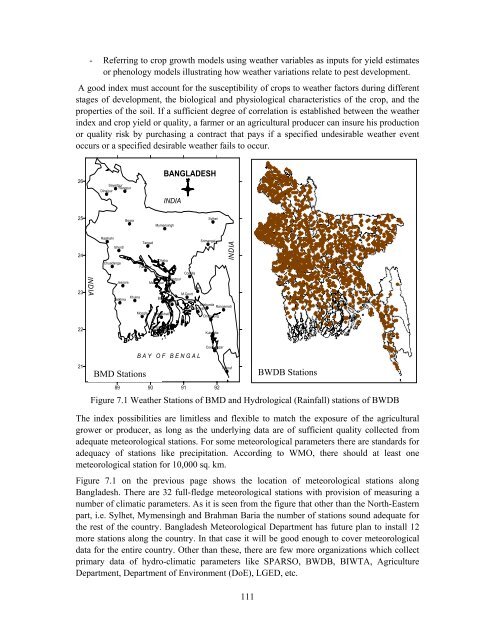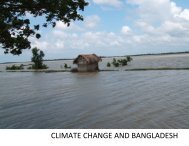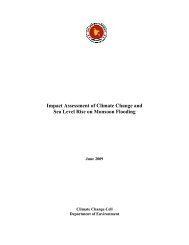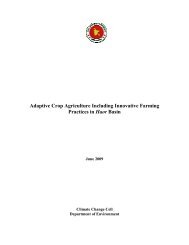Crop Insurance as a Risk Management Strategy in Bangladesh
Crop Insurance as a Risk Management Strategy in Bangladesh
Crop Insurance as a Risk Management Strategy in Bangladesh
Create successful ePaper yourself
Turn your PDF publications into a flip-book with our unique Google optimized e-Paper software.
- Referr<strong>in</strong>g to crop growth models us<strong>in</strong>g weather variables <strong>as</strong> <strong>in</strong>puts for yield estimates<br />
or phenology models illustrat<strong>in</strong>g how weather variations relate to pest development.<br />
A good <strong>in</strong>dex must account for the susceptibility of crops to weather factors dur<strong>in</strong>g different<br />
stages of development, the biological and physiological characteristics of the crop, and the<br />
properties of the soil. If a sufficient degree of correlation is established between the weather<br />
<strong>in</strong>dex and crop yield or quality, a farmer or an agricultural producer can <strong>in</strong>sure his production<br />
or quality risk by purch<strong>as</strong><strong>in</strong>g a contract that pays if a specified undesirable weather event<br />
occurs or a specified desirable weather fails to occur.<br />
26<br />
25<br />
24<br />
23<br />
22<br />
21<br />
INDIA<br />
Sayedpur<br />
Rangpur<br />
D<strong>in</strong>ajpur<br />
Rajshahi<br />
Ishurdi<br />
Chuadanga<br />
Jessore<br />
Satkhira<br />
Bogra<br />
Khulna<br />
Tangail<br />
Faridpur<br />
Mongla<br />
BMD Stations<br />
Mymens<strong>in</strong>gh<br />
Dhaka<br />
Chandpur<br />
Madaripur<br />
Barisal<br />
Bhola<br />
Patuakhali<br />
Khepupara<br />
BANGLADESH<br />
INDIA<br />
Comilla<br />
M.Court<br />
Hatiya<br />
Feni<br />
B A Y O F B E N G A L<br />
Sylhet<br />
Srimangal<br />
Sitakunda<br />
Rangamati<br />
Sandwip<br />
Chittagong<br />
Kutubdia<br />
Coxs_bazar<br />
89 90 91 92<br />
INDIA<br />
Teknaf<br />
The <strong>in</strong>dex possibilities are limitless and flexible to match the exposure of the agricultural<br />
grower or producer, <strong>as</strong> long <strong>as</strong> the underly<strong>in</strong>g data are of sufficient quality collected from<br />
adequate meteorological stations. For some meteorological parameters there are standards for<br />
adequacy of stations like precipitation. Accord<strong>in</strong>g to WMO, there should at le<strong>as</strong>t one<br />
meteorological station for 10,000 sq. km.<br />
Figure 7.1 on the previous page shows the location of meteorological stations along<br />
<strong>Bangladesh</strong>. There are 32 full-fledge meteorological stations with provision of me<strong>as</strong>ur<strong>in</strong>g a<br />
number of climatic parameters. As it is seen from the figure that other than the North-E<strong>as</strong>tern<br />
part, i.e. Sylhet, Mymens<strong>in</strong>gh and Brahman Baria the number of stations sound adequate for<br />
the rest of the country. <strong>Bangladesh</strong> Meteorological Department h<strong>as</strong> future plan to <strong>in</strong>stall 12<br />
more stations along the country. In that c<strong>as</strong>e it will be good enough to cover meteorological<br />
data for the entire country. Other than these, there are few more organizations which collect<br />
primary data of hydro-climatic parameters like SPARSO, BWDB, BIWTA, Agriculture<br />
Department, Department of Environment (DoE), LGED, etc.<br />
111<br />
BWDB Stations<br />
Figure 7.1 Weather Stations of BMD and Hydrological (Ra<strong>in</strong>fall) stations of BWDB





